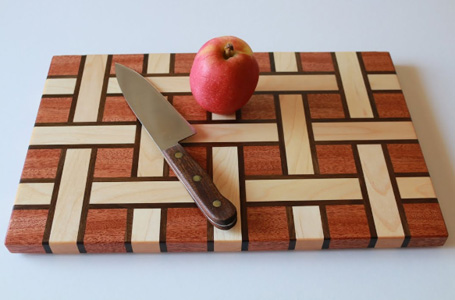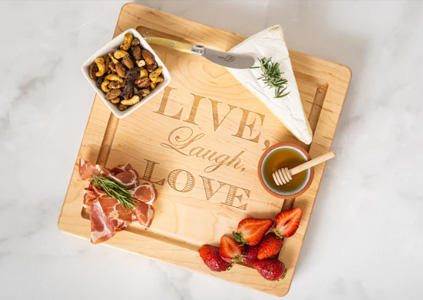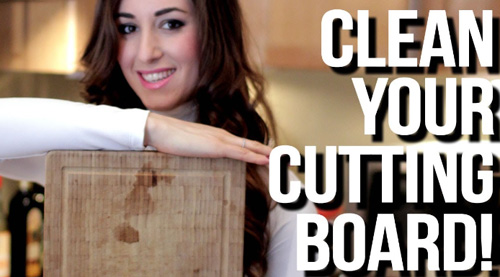How To Store Cutting Boards? 9 Easy Step
Cutting boards are a necessary kitchen tool, but they can be difficult to store. Here are a few tips on how to store your cutting boards so that they are both accessible and protected. One option is to store your cutting boards in a drawer.
This keeps them out of the way and prevents them from being damaged by other items in your kitchen. If you have a large cutting board, you may need to remove some of the other items in the drawer to make room. Another option is to hang your cutting boards on the wall.
This is a good option if you have a lot of space in your kitchen. You can use S-hooks or other hanging hardware to keep your cutting boards off the floor and out of the way. If you have limited space in your kitchen, you can still store your cutting boards safely.
One option is to store them in a plastic bag or container. This will protect them from dust and other debris. You can also stack your cutting boards on top of each other.
This is a good option if you have a small number of cutting boards. No matter how you choose to store your cutting boards, make sure that they are dry and clean before you put them away. This will help to prevent them from warping or developing mold.
Step-by-step Process of How to store cutting boards?
- Clean and dry: Always make sure your cutting board is clean and completely dry before storing it. This prevents the growth of bacteria and mold.
- Store vertically: If possible, store your cutting boards vertically instead of stacking them horizontally. This helps to improve air circulation and reduces the chances of moisture being trapped between the boards.
- Separate cutting boards: If you have multiple cutting boards for different types of food (e.g., one for raw meat and another for fruits and vegetables), store them separately to avoid cross-contamination.
- Use a rack or holder: Consider using a specialized cutting board rack or holder to keep the boards organized and upright. This not only saves space but also helps maintain proper hygiene.
- Avoid heat exposure: Store cutting boards away from direct heat sources, such as stovetops or ovens, as excessive heat can damage the boards and cause warping.
- Keep away from moisture: Avoid storing cutting boards in damp or humid areas, such as under the sink, as moisture can lead to mold growth and deterioration of the board.
- Use a designated cabinet or drawer: If possible, dedicate a specific cabinet or drawer for storing cutting boards. This way, they are protected from dust and other contaminants.
- Consider using non-slip pads: To prevent sliding and rattling inside a cabinet or drawer, you can place non-slip pads or liners between the boards.
- Regularly inspect and replace: Periodically check your cutting boards for signs of wear, deep grooves, or excessive knife marks. If a board becomes too damaged, it’s best to replace it to maintain food safety and hygiene.
By following these guidelines, you can ensure your cutting boards stay in good condition and remain a safe and hygienic tool for your kitchen.
How to store cutting boards on the counter
If you’re like most people, you probably have a couple of cutting boards stored in your kitchen. But did you know that there’s a right way and a wrong way to store them? Here are a few tips to help you keep your cutting boards in tip-top shape:
1. Avoid storing cutting boards in a damp environment. This could cause them to warp or crack.
2. If you’re going to stack cutting boards, make sure to place them on their sides so that the blades don’t touch.
3. Use a cutting board rack or holder to keep your boards organized and easy to grab when you need them.
4. Be sure to clean and sanitize your cutting boards after each use. Following these simple tips, you can help extend the life of your cutting boards and keep them looking like new.
How to Store a Wood Cutting Board?
If you’re like most people, you probably have a wooden cutting board in your kitchen that you use on a regular basis. But what you may not realize is that there are certain steps you need to take in order to ensure that your cutting board stays in good condition. Here are a few tips on how to store a wood cutting board:
1. Avoid extremes of temperature: Just like with any other wooden object in your home, you should avoid storing your cutting board in an environment that is either too hot or too cold. This means keeping it away from the stove and oven, as well as out of the refrigerator or freezer.
2. Keep it dry: Wood is naturally absorbent, so it’s important to keep your cutting board as dry as possible when you’re not using it. This means wiping it down with a clean, dry cloth after each use and stored in a dry place.
3. Don’t let it sit in the water: If your cutting board does get wet, make sure to dry it off as soon as possible. Allowing it to sit in water for extended periods of time can cause the wood to warp and crack.
4. Protect it from scratches: When you’re not using your cutting board, store it in a place where it won’t get scratched or damaged. This means keeping it away from sharp objects like knives.
5. Oil it regularly: To keep your cutting board looking its best, it’s important to oil it on a regular basis. This will help to replenish the natural oils in the wood and keep it from drying out.
By following these simple tips, you can ensure that your wood cutting board will last for many years to come.
How to store chopping boards after cleaning?
If you’re like most people, you probably just toss your chopping boards in a drawer or cabinet after cleaning them. But did you know that there’s a right way and a wrong way to store chopping boards?
The wrong way is to simply throw them in a drawer or cabinet.
This can cause the boards to warp and become misshapen. Plus, it’s just not very sanitary.
The right way to store chopping boards is to hang them on a rack or hooks.
This allows them to air dry properly, preventing bacteria from growing. Plus, it keeps them from warping or becoming misshapen.
If you don’t have a place to hang your chopping boards, you can also store them in a clean, dry cabinet.
Just make sure to prop them up so they’re not touching the bottom of the cabinet, which can retain moisture and lead to bacteria growth.
Hang them up or prop them up in a dry cabinet, and you’ll keep them in good condition for years to come.
How To Store Cutting Board in Drawer?
Assuming you would like a blog post discussing the best ways to store cutting boards: Most people don’t think twice about where they store their cutting boards. However, if you use your cutting boards often, it’s important to store them in a way that keeps them clean and prevents them from becoming damaged.
Here are a few tips for storing your cutting boards:
1. Store cutting boards in a drawer. This is one of the best ways to keep them clean and organized. If you have a lot of cutting boards, invest in a drawer organizer so you can keep them separated.
2. Wrap cutting boards in towels. This will help protect them from getting scratched up in the drawer.
3. Use a cutting board holder. This is a great way to keep your cutting boards organized and easy to grab when you need them.
4. Store cutting boards in the fridge. If you live in a hot climate, storing your cutting boards in the fridge can help prevent them from warping.
5. Don’t store cutting boards near the stove. The heat from the stove can cause cutting boards to warp.
following these simple tips will help you keep your cutting boards in good condition for years to come.
How to Storage Cutting Board Vertical?
There are a few things to consider when storing cutting boards vertically. First, you need to make sure that the boards are properly dried and cleaned before storing them. If they are not, they can warp or mold.
Second, you need to choose a storage method that will allow the boards to air out and not touch each other. This will prevent them from warping or getting damaged. One option for storing cutting boards vertically is to use a wire rack.
This will allow the boards to air out and not touch each other. You can find wire racks at most home improvement stores. Another option is to use S-hooks to hang the boards from a pot rack or wire shelving.
This also allows the boards to air out and not touch each other. Whatever storage method you choose, make sure that the boards are properly dried and clean before storing them. This will prevent them from warping or getting damaged.

Credit: topdreamer.com
How do you store a large wooden cutting board?
Assuming you’re referring to a wood cutting board used in food preparation: The best way to store a wooden cutting board is by hanging it on a wall. This will keep it away from moisture and other elements that could cause it to warp or break.
If you don’t have the space to hang it, you can also store it in a cool, dry place. Wooden cutting boards can last for many years if they’re properly cared for. In addition to storing them properly, you should also clean them after each use with warm water and soap.
You can also use a cutting board oil to keep the wood from drying out.
How do you keep a wooden cutting board sanitary?
Assuming you are referring to a wood cutting board used in food preparation: It is important to keep your cutting board sanitary to avoid cross contamination and foodborne illness. Here are some tips on how to keep your wooden cutting board sanitary:
1. Wash your cutting board with hot, soapy water after each use.
2. Scrub the cutting board with a brush to remove any food particles.
3. Rinse the cutting board with hot water.
4. Dry the cutting board with a clean towel.
5. Disinfect the cutting board by spraying it with a food-safe disinfectant or wiping it down with a solution of 1 tablespoon of bleach per gallon of water.
6. Store the cutting board in a clean, dry place.
By following these simple steps, you can ensure that your cutting board is sanitary and safe to use.
How should cutting boards be stored to avoid moisture build-up?
Your cutting board is one of the most important tools in your kitchen, so it’s important to take care of it. One of the main problems with cutting boards is moisture build up. If your cutting board is stored in a humid environment, it can start to warp and crack.
There are a few things you can do to avoid moisture build up on your cutting board. First, make sure that you store your cutting board in a dry place. If you’re not using it, keep it in a cupboard or drawer.
If you’re using it, make sure to dry it off after each use. Second, if your cutting board is made of wood, oil it regularly. This will help to create a barrier against moisture.
Finally, don’t store your cutting board next to the sink. The humidity from the sink can cause the cutting board to warp. By following these simple tips, you can keep your cutting board in good condition for years to come.
How long should you keep a wooden cutting board?
Assuming you are referring to a wooden cutting board used in food preparation:
The general rule of thumb is to replace your wooden cutting board when it starts to show signs of wear and tear, such as cracks, warping, or deep cuts. A well-cared for wooden cutting board can last for many years.
Here are a few tips to help you extend the life of your wooden cutting board:
– avoid using it for tasks that would damage the board, such as cutting frozen foods or bone-in meats
– never put it in the dishwasher – the harsh detergents and heat will damage the wood
– clean it thoroughly with hot water and soap after each use, and then rinse and dry it
Conclusion
When it comes to storing cutting boards, there are a few things to keep in mind. First, it’s important to make sure that the boards are clean and dry before storing them. If they’re not, they can develop mold or bacteria.
Second, it’s best to store them in a cool, dry place. A kitchen cabinet or pantry is ideal. Finally, it’s important to keep them away from other food items, as they can absorb odors.

![How to Clean Wooden Cutting Board Mold [Expert Tips]](https://kitchenapplince.com/wp-content/uploads/2022/08/How-to-Clean-Wooden-Cutting-Board-Mold.jpg)


